Qualitative Research Methods Project: Autism Parental Challenges
VerifiedAdded on 2022/12/29
|9
|2439
|1
Project
AI Summary
This project undertakes a detailed analysis of four articles employing qualitative research methods to explore the challenges encountered by parents of children diagnosed with autism spectrum disorder (ASD). The methodologies employed include ethnographic techniques involving in-depth interviews and observations, literature reviews, and grounded theory approaches. The studies investigate various aspects, including parental coping strategies, the impact of autism on family life and parental well-being, and the validity and generalizability of research findings. The project critically assesses the strengths and weaknesses of each study, considering sample sizes, participant demographics, and the use of diverse data collection methods. The analysis highlights the importance of robust methodologies, diverse perspectives, and the inclusion of healthcare professionals to ensure the validity, rigor, and generalizability of research outcomes. The project concludes with a comparative analysis, identifying best practices for future research in this critical area and the validity of the analyzed articles.
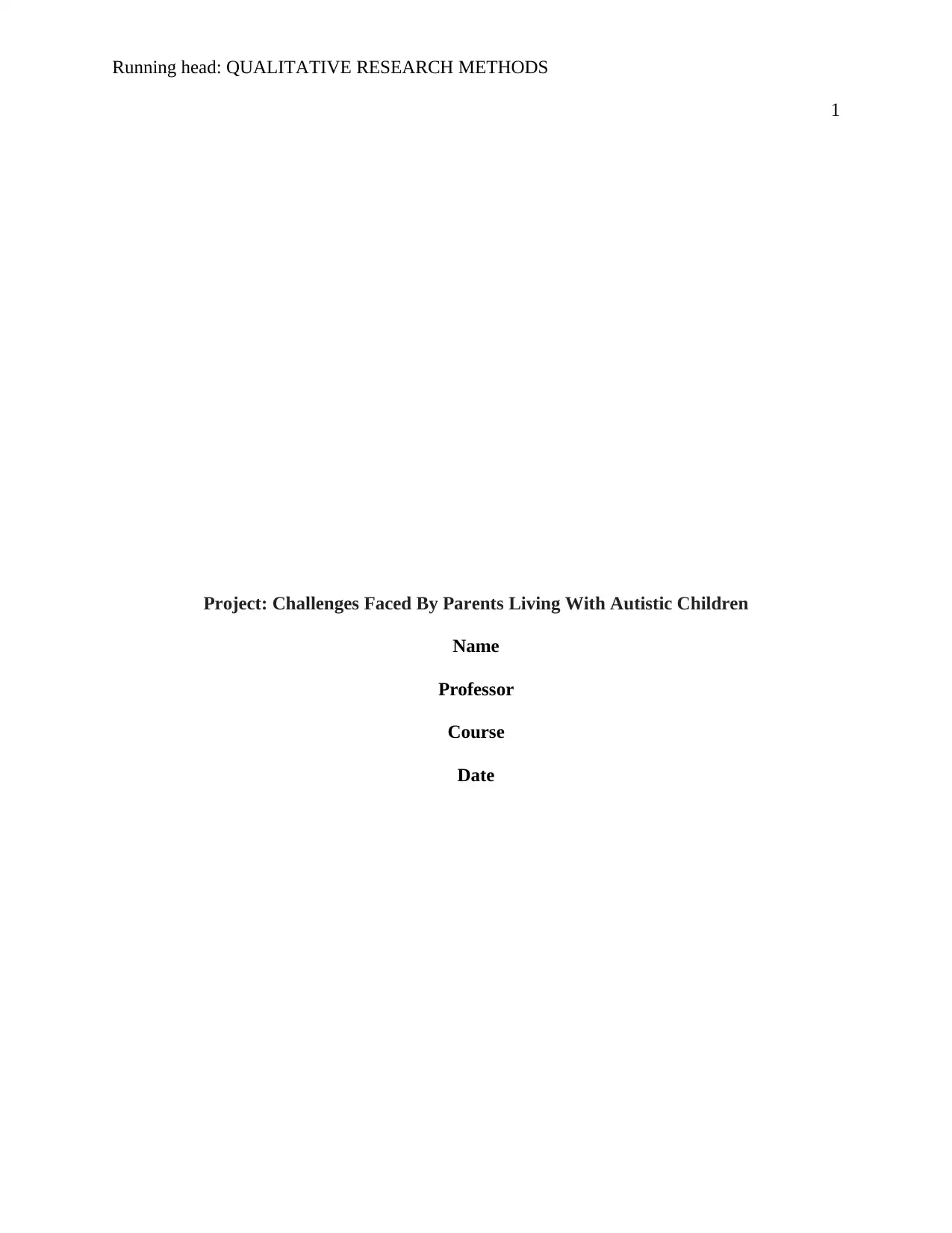
Running head: QUALITATIVE RESEARCH METHODS
1
Project: Challenges Faced By Parents Living With Autistic Children
Name
Professor
Course
Date
1
Project: Challenges Faced By Parents Living With Autistic Children
Name
Professor
Course
Date
Paraphrase This Document
Need a fresh take? Get an instant paraphrase of this document with our AI Paraphraser
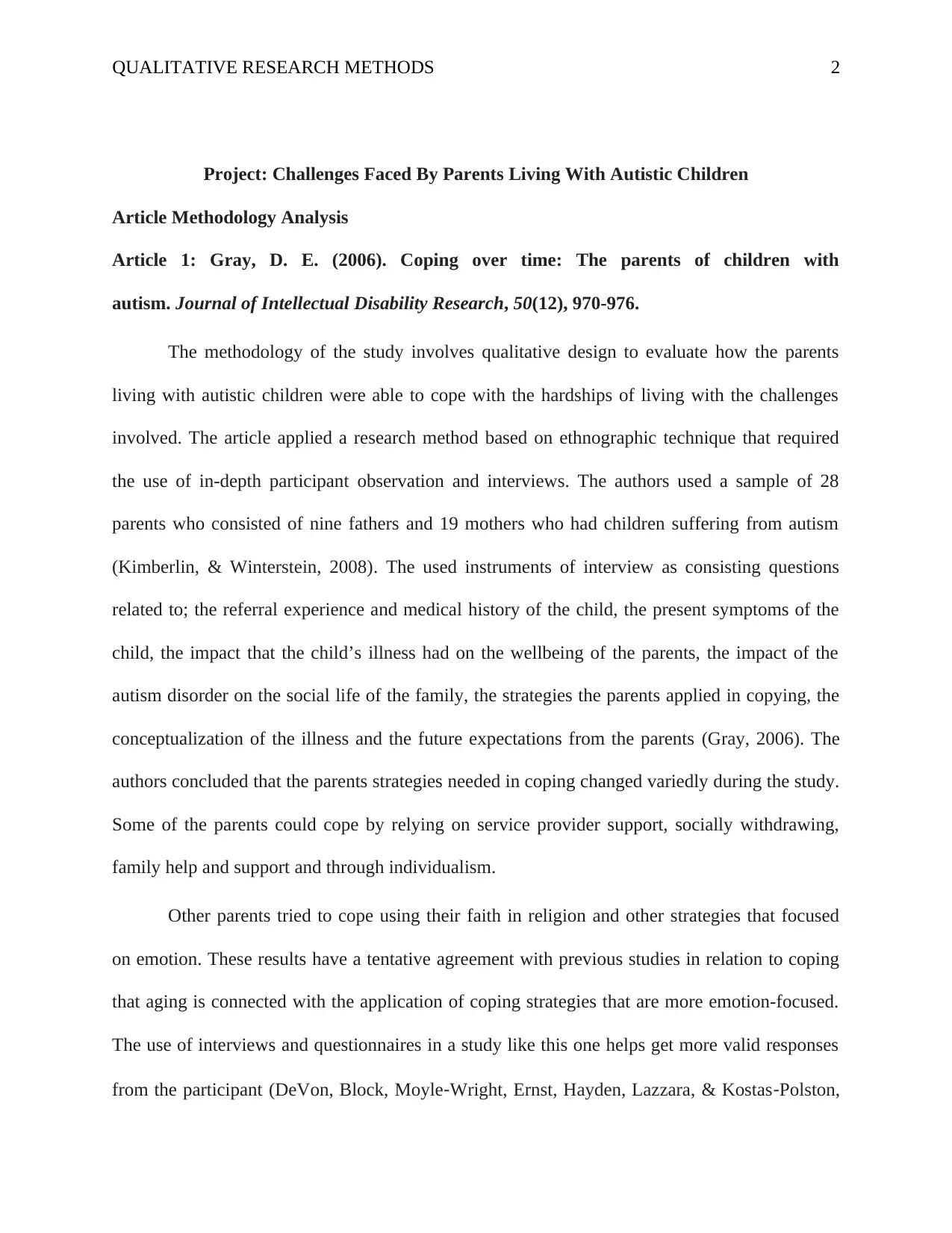
QUALITATIVE RESEARCH METHODS 2
Project: Challenges Faced By Parents Living With Autistic Children
Article Methodology Analysis
Article 1: Gray, D. E. (2006). Coping over time: The parents of children with
autism. Journal of Intellectual Disability Research, 50(12), 970-976.
The methodology of the study involves qualitative design to evaluate how the parents
living with autistic children were able to cope with the hardships of living with the challenges
involved. The article applied a research method based on ethnographic technique that required
the use of in-depth participant observation and interviews. The authors used a sample of 28
parents who consisted of nine fathers and 19 mothers who had children suffering from autism
(Kimberlin, & Winterstein, 2008). The used instruments of interview as consisting questions
related to; the referral experience and medical history of the child, the present symptoms of the
child, the impact that the child’s illness had on the wellbeing of the parents, the impact of the
autism disorder on the social life of the family, the strategies the parents applied in copying, the
conceptualization of the illness and the future expectations from the parents (Gray, 2006). The
authors concluded that the parents strategies needed in coping changed variedly during the study.
Some of the parents could cope by relying on service provider support, socially withdrawing,
family help and support and through individualism.
Other parents tried to cope using their faith in religion and other strategies that focused
on emotion. These results have a tentative agreement with previous studies in relation to coping
that aging is connected with the application of coping strategies that are more emotion-focused.
The use of interviews and questionnaires in a study like this one helps get more valid responses
from the participant (DeVon, Block, Moyle‐Wright, Ernst, Hayden, Lazzara, & Kostas‐Polston,
Project: Challenges Faced By Parents Living With Autistic Children
Article Methodology Analysis
Article 1: Gray, D. E. (2006). Coping over time: The parents of children with
autism. Journal of Intellectual Disability Research, 50(12), 970-976.
The methodology of the study involves qualitative design to evaluate how the parents
living with autistic children were able to cope with the hardships of living with the challenges
involved. The article applied a research method based on ethnographic technique that required
the use of in-depth participant observation and interviews. The authors used a sample of 28
parents who consisted of nine fathers and 19 mothers who had children suffering from autism
(Kimberlin, & Winterstein, 2008). The used instruments of interview as consisting questions
related to; the referral experience and medical history of the child, the present symptoms of the
child, the impact that the child’s illness had on the wellbeing of the parents, the impact of the
autism disorder on the social life of the family, the strategies the parents applied in copying, the
conceptualization of the illness and the future expectations from the parents (Gray, 2006). The
authors concluded that the parents strategies needed in coping changed variedly during the study.
Some of the parents could cope by relying on service provider support, socially withdrawing,
family help and support and through individualism.
Other parents tried to cope using their faith in religion and other strategies that focused
on emotion. These results have a tentative agreement with previous studies in relation to coping
that aging is connected with the application of coping strategies that are more emotion-focused.
The use of interviews and questionnaires in a study like this one helps get more valid responses
from the participant (DeVon, Block, Moyle‐Wright, Ernst, Hayden, Lazzara, & Kostas‐Polston,
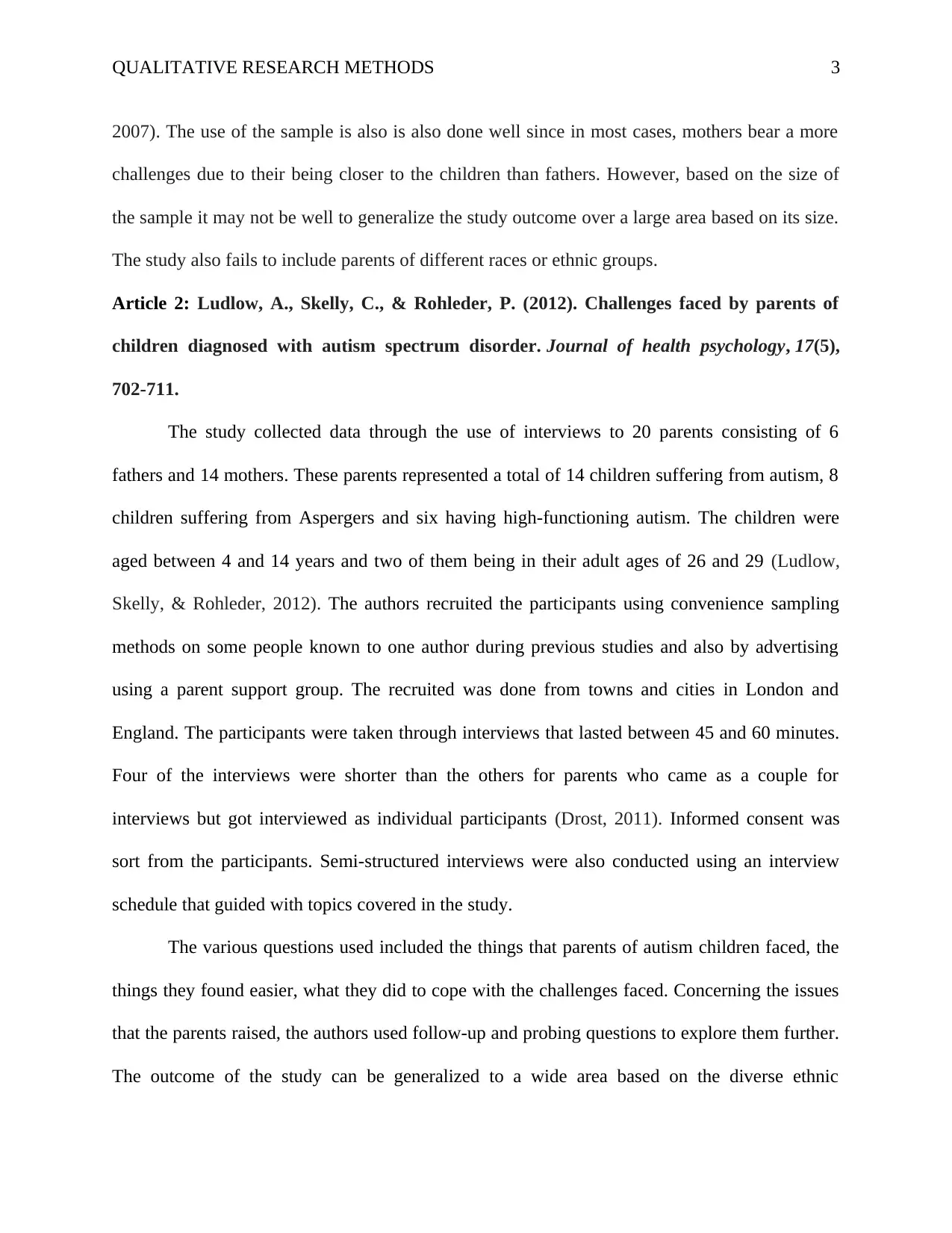
QUALITATIVE RESEARCH METHODS 3
2007). The use of the sample is also is also done well since in most cases, mothers bear a more
challenges due to their being closer to the children than fathers. However, based on the size of
the sample it may not be well to generalize the study outcome over a large area based on its size.
The study also fails to include parents of different races or ethnic groups.
Article 2: Ludlow, A., Skelly, C., & Rohleder, P. (2012). Challenges faced by parents of
children diagnosed with autism spectrum disorder. Journal of health psychology, 17(5),
702-711.
The study collected data through the use of interviews to 20 parents consisting of 6
fathers and 14 mothers. These parents represented a total of 14 children suffering from autism, 8
children suffering from Aspergers and six having high-functioning autism. The children were
aged between 4 and 14 years and two of them being in their adult ages of 26 and 29 (Ludlow,
Skelly, & Rohleder, 2012). The authors recruited the participants using convenience sampling
methods on some people known to one author during previous studies and also by advertising
using a parent support group. The recruited was done from towns and cities in London and
England. The participants were taken through interviews that lasted between 45 and 60 minutes.
Four of the interviews were shorter than the others for parents who came as a couple for
interviews but got interviewed as individual participants (Drost, 2011). Informed consent was
sort from the participants. Semi-structured interviews were also conducted using an interview
schedule that guided with topics covered in the study.
The various questions used included the things that parents of autism children faced, the
things they found easier, what they did to cope with the challenges faced. Concerning the issues
that the parents raised, the authors used follow-up and probing questions to explore them further.
The outcome of the study can be generalized to a wide area based on the diverse ethnic
2007). The use of the sample is also is also done well since in most cases, mothers bear a more
challenges due to their being closer to the children than fathers. However, based on the size of
the sample it may not be well to generalize the study outcome over a large area based on its size.
The study also fails to include parents of different races or ethnic groups.
Article 2: Ludlow, A., Skelly, C., & Rohleder, P. (2012). Challenges faced by parents of
children diagnosed with autism spectrum disorder. Journal of health psychology, 17(5),
702-711.
The study collected data through the use of interviews to 20 parents consisting of 6
fathers and 14 mothers. These parents represented a total of 14 children suffering from autism, 8
children suffering from Aspergers and six having high-functioning autism. The children were
aged between 4 and 14 years and two of them being in their adult ages of 26 and 29 (Ludlow,
Skelly, & Rohleder, 2012). The authors recruited the participants using convenience sampling
methods on some people known to one author during previous studies and also by advertising
using a parent support group. The recruited was done from towns and cities in London and
England. The participants were taken through interviews that lasted between 45 and 60 minutes.
Four of the interviews were shorter than the others for parents who came as a couple for
interviews but got interviewed as individual participants (Drost, 2011). Informed consent was
sort from the participants. Semi-structured interviews were also conducted using an interview
schedule that guided with topics covered in the study.
The various questions used included the things that parents of autism children faced, the
things they found easier, what they did to cope with the challenges faced. Concerning the issues
that the parents raised, the authors used follow-up and probing questions to explore them further.
The outcome of the study can be generalized to a wide area based on the diverse ethnic
⊘ This is a preview!⊘
Do you want full access?
Subscribe today to unlock all pages.

Trusted by 1+ million students worldwide
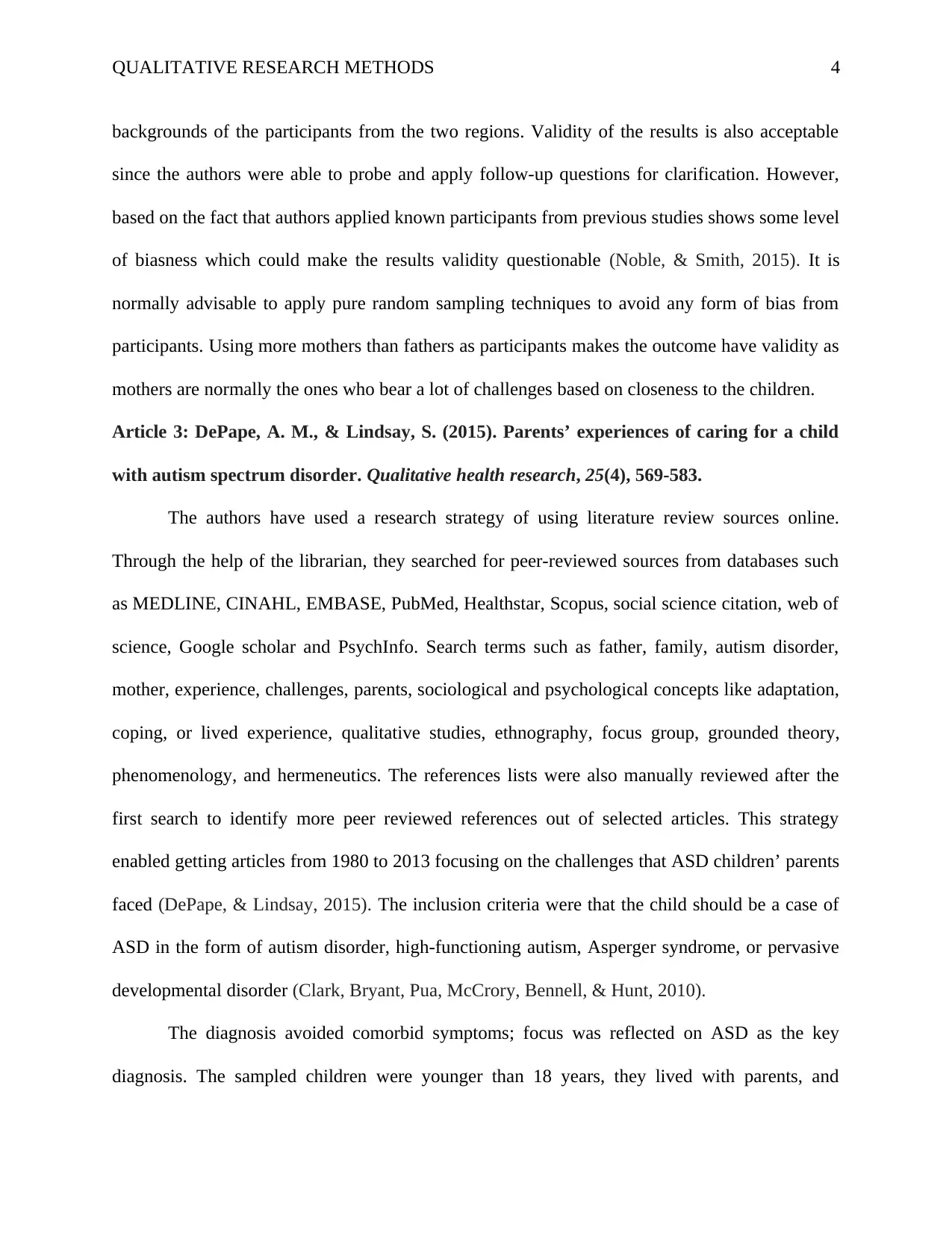
QUALITATIVE RESEARCH METHODS 4
backgrounds of the participants from the two regions. Validity of the results is also acceptable
since the authors were able to probe and apply follow-up questions for clarification. However,
based on the fact that authors applied known participants from previous studies shows some level
of biasness which could make the results validity questionable (Noble, & Smith, 2015). It is
normally advisable to apply pure random sampling techniques to avoid any form of bias from
participants. Using more mothers than fathers as participants makes the outcome have validity as
mothers are normally the ones who bear a lot of challenges based on closeness to the children.
Article 3: DePape, A. M., & Lindsay, S. (2015). Parents’ experiences of caring for a child
with autism spectrum disorder. Qualitative health research, 25(4), 569-583.
The authors have used a research strategy of using literature review sources online.
Through the help of the librarian, they searched for peer-reviewed sources from databases such
as MEDLINE, CINAHL, EMBASE, PubMed, Healthstar, Scopus, social science citation, web of
science, Google scholar and PsychInfo. Search terms such as father, family, autism disorder,
mother, experience, challenges, parents, sociological and psychological concepts like adaptation,
coping, or lived experience, qualitative studies, ethnography, focus group, grounded theory,
phenomenology, and hermeneutics. The references lists were also manually reviewed after the
first search to identify more peer reviewed references out of selected articles. This strategy
enabled getting articles from 1980 to 2013 focusing on the challenges that ASD children’ parents
faced (DePape, & Lindsay, 2015). The inclusion criteria were that the child should be a case of
ASD in the form of autism disorder, high-functioning autism, Asperger syndrome, or pervasive
developmental disorder (Clark, Bryant, Pua, McCrory, Bennell, & Hunt, 2010).
The diagnosis avoided comorbid symptoms; focus was reflected on ASD as the key
diagnosis. The sampled children were younger than 18 years, they lived with parents, and
backgrounds of the participants from the two regions. Validity of the results is also acceptable
since the authors were able to probe and apply follow-up questions for clarification. However,
based on the fact that authors applied known participants from previous studies shows some level
of biasness which could make the results validity questionable (Noble, & Smith, 2015). It is
normally advisable to apply pure random sampling techniques to avoid any form of bias from
participants. Using more mothers than fathers as participants makes the outcome have validity as
mothers are normally the ones who bear a lot of challenges based on closeness to the children.
Article 3: DePape, A. M., & Lindsay, S. (2015). Parents’ experiences of caring for a child
with autism spectrum disorder. Qualitative health research, 25(4), 569-583.
The authors have used a research strategy of using literature review sources online.
Through the help of the librarian, they searched for peer-reviewed sources from databases such
as MEDLINE, CINAHL, EMBASE, PubMed, Healthstar, Scopus, social science citation, web of
science, Google scholar and PsychInfo. Search terms such as father, family, autism disorder,
mother, experience, challenges, parents, sociological and psychological concepts like adaptation,
coping, or lived experience, qualitative studies, ethnography, focus group, grounded theory,
phenomenology, and hermeneutics. The references lists were also manually reviewed after the
first search to identify more peer reviewed references out of selected articles. This strategy
enabled getting articles from 1980 to 2013 focusing on the challenges that ASD children’ parents
faced (DePape, & Lindsay, 2015). The inclusion criteria were that the child should be a case of
ASD in the form of autism disorder, high-functioning autism, Asperger syndrome, or pervasive
developmental disorder (Clark, Bryant, Pua, McCrory, Bennell, & Hunt, 2010).
The diagnosis avoided comorbid symptoms; focus was reflected on ASD as the key
diagnosis. The sampled children were younger than 18 years, they lived with parents, and
Paraphrase This Document
Need a fresh take? Get an instant paraphrase of this document with our AI Paraphraser
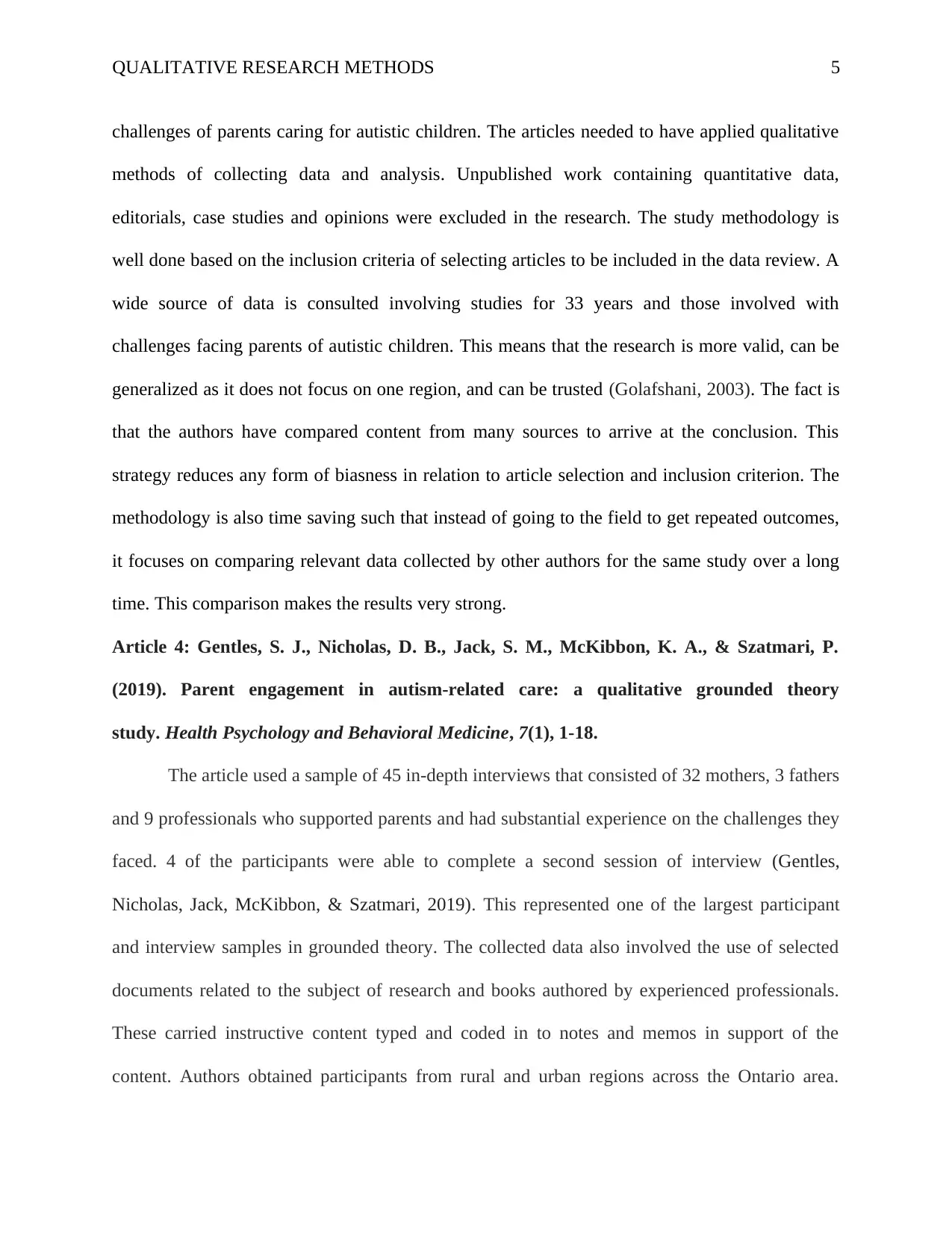
QUALITATIVE RESEARCH METHODS 5
challenges of parents caring for autistic children. The articles needed to have applied qualitative
methods of collecting data and analysis. Unpublished work containing quantitative data,
editorials, case studies and opinions were excluded in the research. The study methodology is
well done based on the inclusion criteria of selecting articles to be included in the data review. A
wide source of data is consulted involving studies for 33 years and those involved with
challenges facing parents of autistic children. This means that the research is more valid, can be
generalized as it does not focus on one region, and can be trusted (Golafshani, 2003). The fact is
that the authors have compared content from many sources to arrive at the conclusion. This
strategy reduces any form of biasness in relation to article selection and inclusion criterion. The
methodology is also time saving such that instead of going to the field to get repeated outcomes,
it focuses on comparing relevant data collected by other authors for the same study over a long
time. This comparison makes the results very strong.
Article 4: Gentles, S. J., Nicholas, D. B., Jack, S. M., McKibbon, K. A., & Szatmari, P.
(2019). Parent engagement in autism-related care: a qualitative grounded theory
study. Health Psychology and Behavioral Medicine, 7(1), 1-18.
The article used a sample of 45 in-depth interviews that consisted of 32 mothers, 3 fathers
and 9 professionals who supported parents and had substantial experience on the challenges they
faced. 4 of the participants were able to complete a second session of interview (Gentles,
Nicholas, Jack, McKibbon, & Szatmari, 2019). This represented one of the largest participant
and interview samples in grounded theory. The collected data also involved the use of selected
documents related to the subject of research and books authored by experienced professionals.
These carried instructive content typed and coded in to notes and memos in support of the
content. Authors obtained participants from rural and urban regions across the Ontario area.
challenges of parents caring for autistic children. The articles needed to have applied qualitative
methods of collecting data and analysis. Unpublished work containing quantitative data,
editorials, case studies and opinions were excluded in the research. The study methodology is
well done based on the inclusion criteria of selecting articles to be included in the data review. A
wide source of data is consulted involving studies for 33 years and those involved with
challenges facing parents of autistic children. This means that the research is more valid, can be
generalized as it does not focus on one region, and can be trusted (Golafshani, 2003). The fact is
that the authors have compared content from many sources to arrive at the conclusion. This
strategy reduces any form of biasness in relation to article selection and inclusion criterion. The
methodology is also time saving such that instead of going to the field to get repeated outcomes,
it focuses on comparing relevant data collected by other authors for the same study over a long
time. This comparison makes the results very strong.
Article 4: Gentles, S. J., Nicholas, D. B., Jack, S. M., McKibbon, K. A., & Szatmari, P.
(2019). Parent engagement in autism-related care: a qualitative grounded theory
study. Health Psychology and Behavioral Medicine, 7(1), 1-18.
The article used a sample of 45 in-depth interviews that consisted of 32 mothers, 3 fathers
and 9 professionals who supported parents and had substantial experience on the challenges they
faced. 4 of the participants were able to complete a second session of interview (Gentles,
Nicholas, Jack, McKibbon, & Szatmari, 2019). This represented one of the largest participant
and interview samples in grounded theory. The collected data also involved the use of selected
documents related to the subject of research and books authored by experienced professionals.
These carried instructive content typed and coded in to notes and memos in support of the
content. Authors obtained participants from rural and urban regions across the Ontario area.
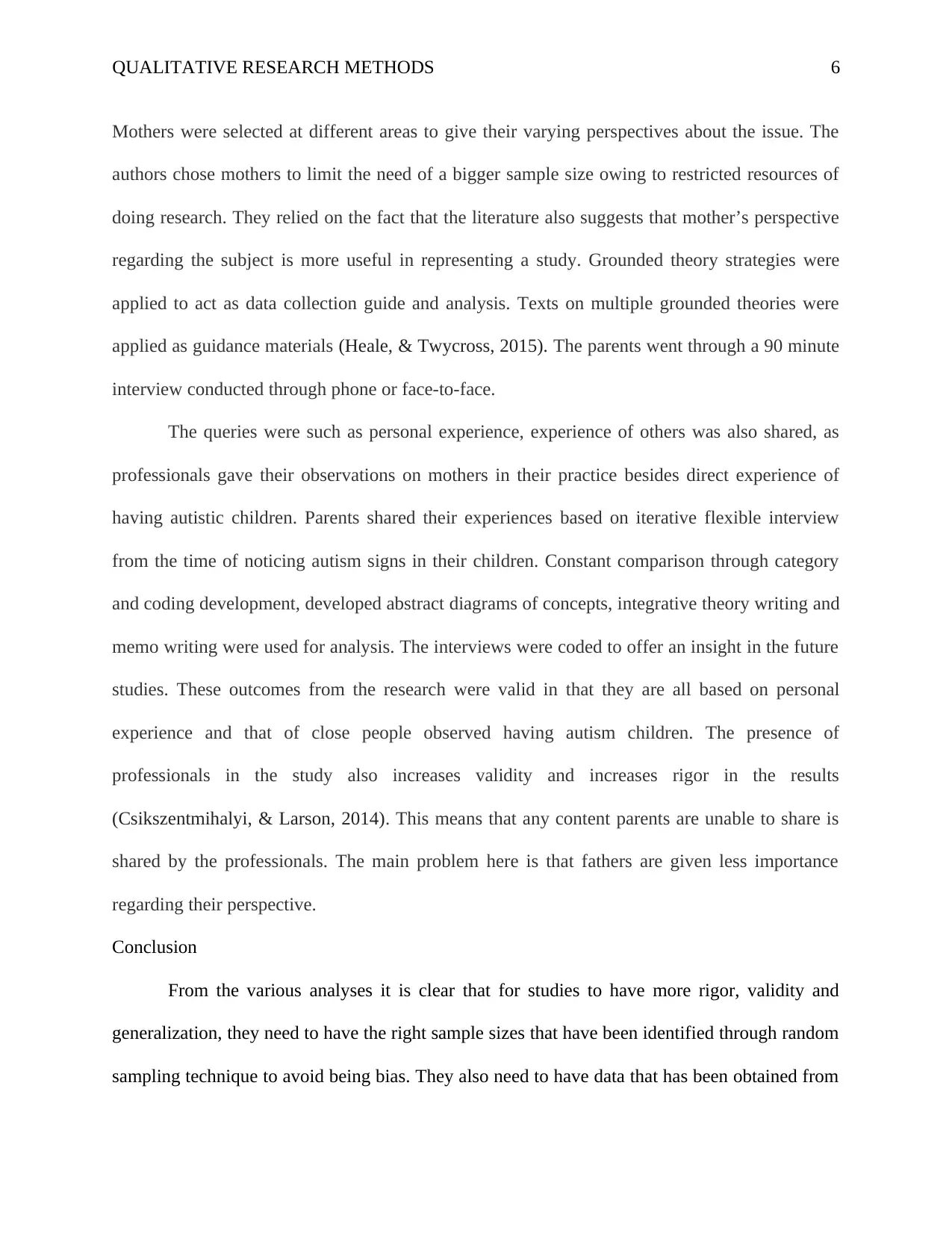
QUALITATIVE RESEARCH METHODS 6
Mothers were selected at different areas to give their varying perspectives about the issue. The
authors chose mothers to limit the need of a bigger sample size owing to restricted resources of
doing research. They relied on the fact that the literature also suggests that mother’s perspective
regarding the subject is more useful in representing a study. Grounded theory strategies were
applied to act as data collection guide and analysis. Texts on multiple grounded theories were
applied as guidance materials (Heale, & Twycross, 2015). The parents went through a 90 minute
interview conducted through phone or face-to-face.
The queries were such as personal experience, experience of others was also shared, as
professionals gave their observations on mothers in their practice besides direct experience of
having autistic children. Parents shared their experiences based on iterative flexible interview
from the time of noticing autism signs in their children. Constant comparison through category
and coding development, developed abstract diagrams of concepts, integrative theory writing and
memo writing were used for analysis. The interviews were coded to offer an insight in the future
studies. These outcomes from the research were valid in that they are all based on personal
experience and that of close people observed having autism children. The presence of
professionals in the study also increases validity and increases rigor in the results
(Csikszentmihalyi, & Larson, 2014). This means that any content parents are unable to share is
shared by the professionals. The main problem here is that fathers are given less importance
regarding their perspective.
Conclusion
From the various analyses it is clear that for studies to have more rigor, validity and
generalization, they need to have the right sample sizes that have been identified through random
sampling technique to avoid being bias. They also need to have data that has been obtained from
Mothers were selected at different areas to give their varying perspectives about the issue. The
authors chose mothers to limit the need of a bigger sample size owing to restricted resources of
doing research. They relied on the fact that the literature also suggests that mother’s perspective
regarding the subject is more useful in representing a study. Grounded theory strategies were
applied to act as data collection guide and analysis. Texts on multiple grounded theories were
applied as guidance materials (Heale, & Twycross, 2015). The parents went through a 90 minute
interview conducted through phone or face-to-face.
The queries were such as personal experience, experience of others was also shared, as
professionals gave their observations on mothers in their practice besides direct experience of
having autistic children. Parents shared their experiences based on iterative flexible interview
from the time of noticing autism signs in their children. Constant comparison through category
and coding development, developed abstract diagrams of concepts, integrative theory writing and
memo writing were used for analysis. The interviews were coded to offer an insight in the future
studies. These outcomes from the research were valid in that they are all based on personal
experience and that of close people observed having autism children. The presence of
professionals in the study also increases validity and increases rigor in the results
(Csikszentmihalyi, & Larson, 2014). This means that any content parents are unable to share is
shared by the professionals. The main problem here is that fathers are given less importance
regarding their perspective.
Conclusion
From the various analyses it is clear that for studies to have more rigor, validity and
generalization, they need to have the right sample sizes that have been identified through random
sampling technique to avoid being bias. They also need to have data that has been obtained from
⊘ This is a preview!⊘
Do you want full access?
Subscribe today to unlock all pages.

Trusted by 1+ million students worldwide
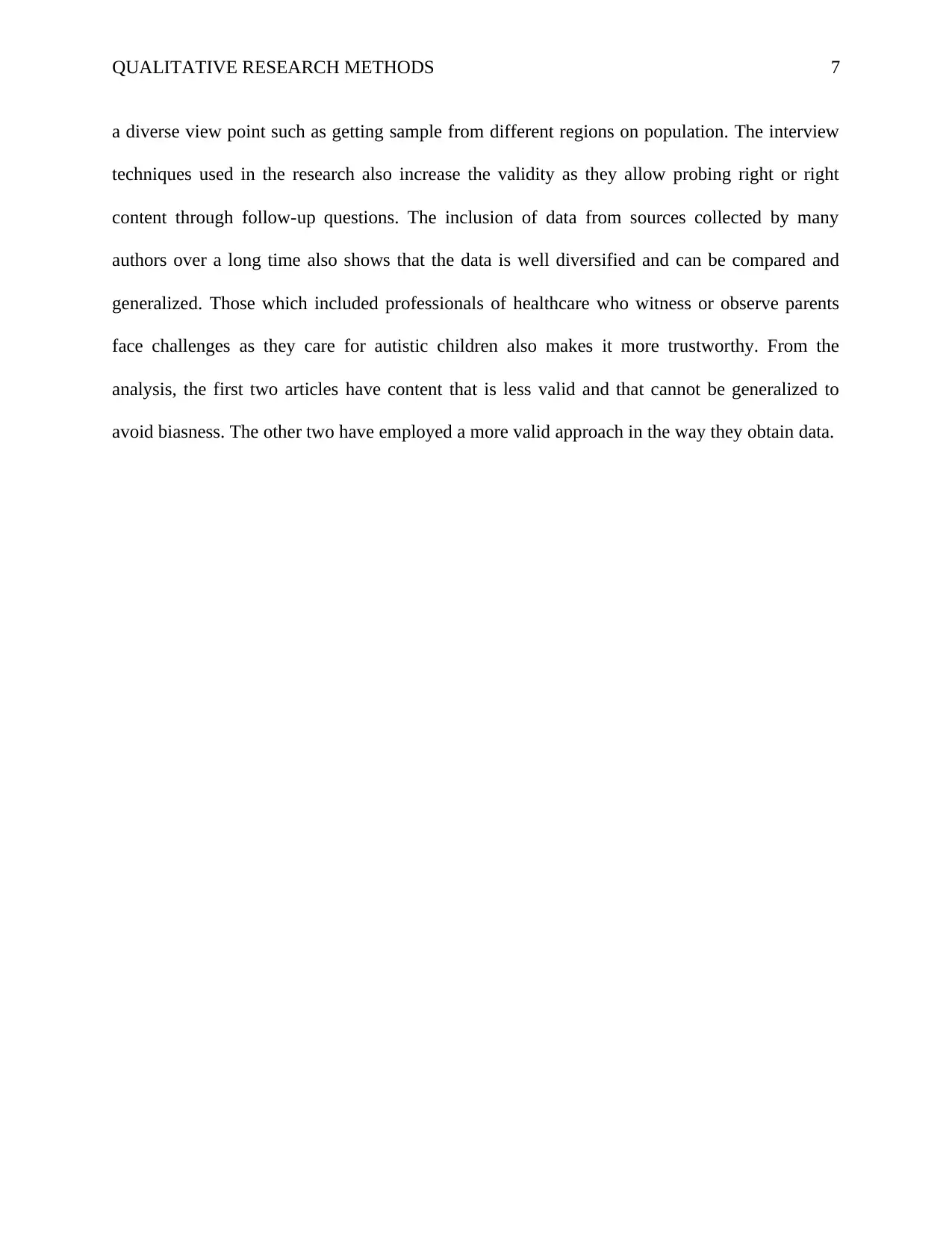
QUALITATIVE RESEARCH METHODS 7
a diverse view point such as getting sample from different regions on population. The interview
techniques used in the research also increase the validity as they allow probing right or right
content through follow-up questions. The inclusion of data from sources collected by many
authors over a long time also shows that the data is well diversified and can be compared and
generalized. Those which included professionals of healthcare who witness or observe parents
face challenges as they care for autistic children also makes it more trustworthy. From the
analysis, the first two articles have content that is less valid and that cannot be generalized to
avoid biasness. The other two have employed a more valid approach in the way they obtain data.
a diverse view point such as getting sample from different regions on population. The interview
techniques used in the research also increase the validity as they allow probing right or right
content through follow-up questions. The inclusion of data from sources collected by many
authors over a long time also shows that the data is well diversified and can be compared and
generalized. Those which included professionals of healthcare who witness or observe parents
face challenges as they care for autistic children also makes it more trustworthy. From the
analysis, the first two articles have content that is less valid and that cannot be generalized to
avoid biasness. The other two have employed a more valid approach in the way they obtain data.
Paraphrase This Document
Need a fresh take? Get an instant paraphrase of this document with our AI Paraphraser
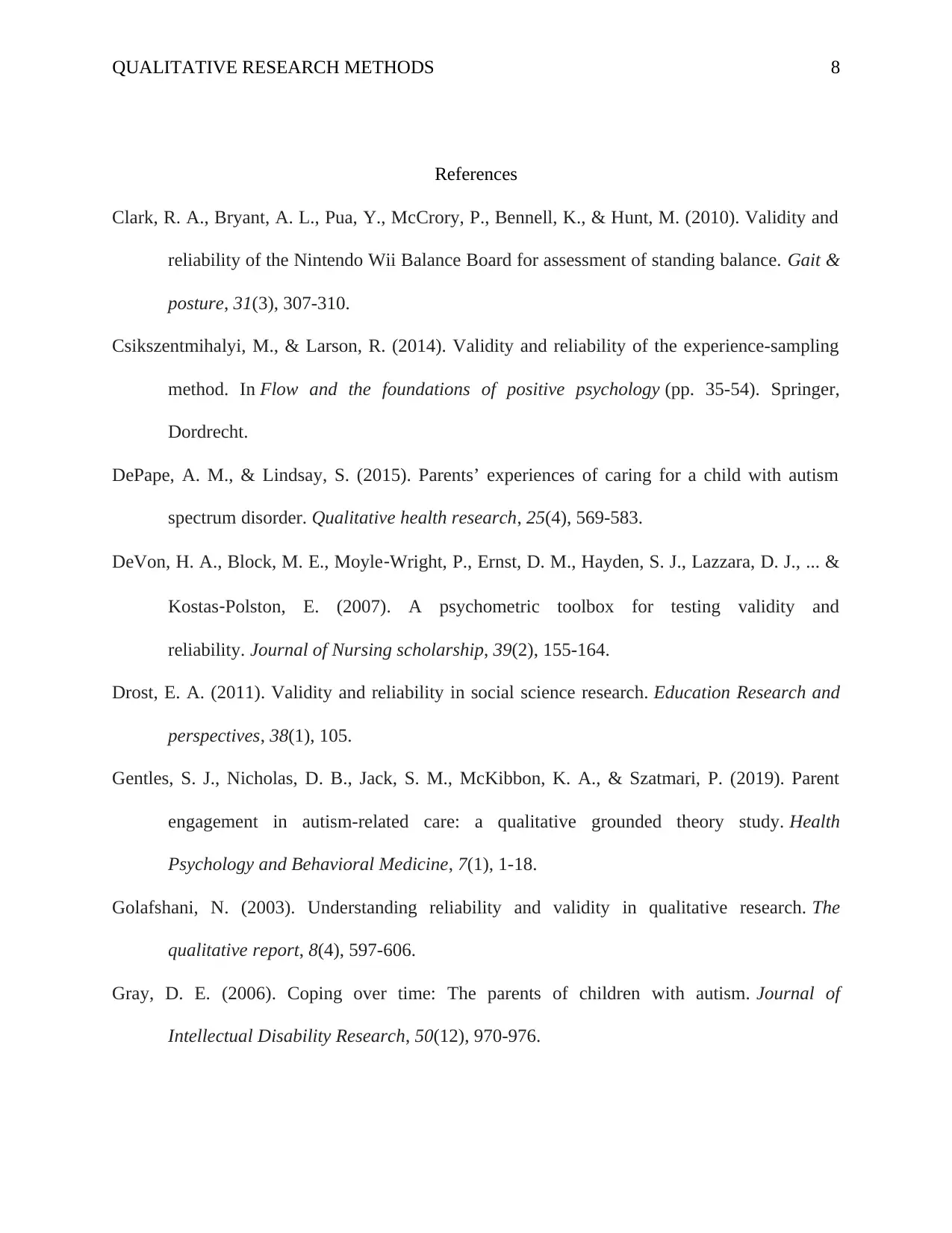
QUALITATIVE RESEARCH METHODS 8
References
Clark, R. A., Bryant, A. L., Pua, Y., McCrory, P., Bennell, K., & Hunt, M. (2010). Validity and
reliability of the Nintendo Wii Balance Board for assessment of standing balance. Gait &
posture, 31(3), 307-310.
Csikszentmihalyi, M., & Larson, R. (2014). Validity and reliability of the experience-sampling
method. In Flow and the foundations of positive psychology (pp. 35-54). Springer,
Dordrecht.
DePape, A. M., & Lindsay, S. (2015). Parents’ experiences of caring for a child with autism
spectrum disorder. Qualitative health research, 25(4), 569-583.
DeVon, H. A., Block, M. E., Moyle‐Wright, P., Ernst, D. M., Hayden, S. J., Lazzara, D. J., ... &
Kostas‐Polston, E. (2007). A psychometric toolbox for testing validity and
reliability. Journal of Nursing scholarship, 39(2), 155-164.
Drost, E. A. (2011). Validity and reliability in social science research. Education Research and
perspectives, 38(1), 105.
Gentles, S. J., Nicholas, D. B., Jack, S. M., McKibbon, K. A., & Szatmari, P. (2019). Parent
engagement in autism-related care: a qualitative grounded theory study. Health
Psychology and Behavioral Medicine, 7(1), 1-18.
Golafshani, N. (2003). Understanding reliability and validity in qualitative research. The
qualitative report, 8(4), 597-606.
Gray, D. E. (2006). Coping over time: The parents of children with autism. Journal of
Intellectual Disability Research, 50(12), 970-976.
References
Clark, R. A., Bryant, A. L., Pua, Y., McCrory, P., Bennell, K., & Hunt, M. (2010). Validity and
reliability of the Nintendo Wii Balance Board for assessment of standing balance. Gait &
posture, 31(3), 307-310.
Csikszentmihalyi, M., & Larson, R. (2014). Validity and reliability of the experience-sampling
method. In Flow and the foundations of positive psychology (pp. 35-54). Springer,
Dordrecht.
DePape, A. M., & Lindsay, S. (2015). Parents’ experiences of caring for a child with autism
spectrum disorder. Qualitative health research, 25(4), 569-583.
DeVon, H. A., Block, M. E., Moyle‐Wright, P., Ernst, D. M., Hayden, S. J., Lazzara, D. J., ... &
Kostas‐Polston, E. (2007). A psychometric toolbox for testing validity and
reliability. Journal of Nursing scholarship, 39(2), 155-164.
Drost, E. A. (2011). Validity and reliability in social science research. Education Research and
perspectives, 38(1), 105.
Gentles, S. J., Nicholas, D. B., Jack, S. M., McKibbon, K. A., & Szatmari, P. (2019). Parent
engagement in autism-related care: a qualitative grounded theory study. Health
Psychology and Behavioral Medicine, 7(1), 1-18.
Golafshani, N. (2003). Understanding reliability and validity in qualitative research. The
qualitative report, 8(4), 597-606.
Gray, D. E. (2006). Coping over time: The parents of children with autism. Journal of
Intellectual Disability Research, 50(12), 970-976.
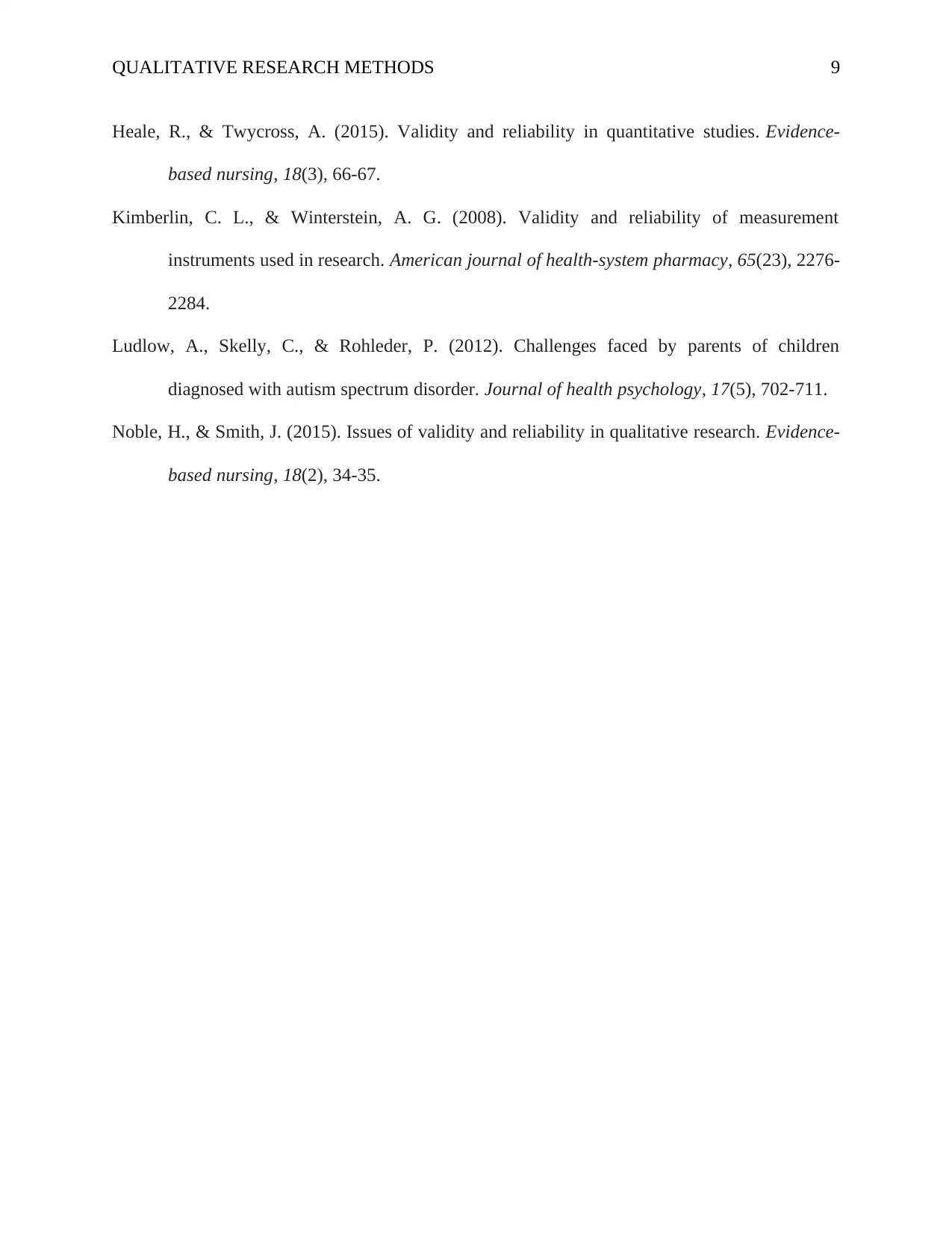
QUALITATIVE RESEARCH METHODS 9
Heale, R., & Twycross, A. (2015). Validity and reliability in quantitative studies. Evidence-
based nursing, 18(3), 66-67.
Kimberlin, C. L., & Winterstein, A. G. (2008). Validity and reliability of measurement
instruments used in research. American journal of health-system pharmacy, 65(23), 2276-
2284.
Ludlow, A., Skelly, C., & Rohleder, P. (2012). Challenges faced by parents of children
diagnosed with autism spectrum disorder. Journal of health psychology, 17(5), 702-711.
Noble, H., & Smith, J. (2015). Issues of validity and reliability in qualitative research. Evidence-
based nursing, 18(2), 34-35.
Heale, R., & Twycross, A. (2015). Validity and reliability in quantitative studies. Evidence-
based nursing, 18(3), 66-67.
Kimberlin, C. L., & Winterstein, A. G. (2008). Validity and reliability of measurement
instruments used in research. American journal of health-system pharmacy, 65(23), 2276-
2284.
Ludlow, A., Skelly, C., & Rohleder, P. (2012). Challenges faced by parents of children
diagnosed with autism spectrum disorder. Journal of health psychology, 17(5), 702-711.
Noble, H., & Smith, J. (2015). Issues of validity and reliability in qualitative research. Evidence-
based nursing, 18(2), 34-35.
⊘ This is a preview!⊘
Do you want full access?
Subscribe today to unlock all pages.

Trusted by 1+ million students worldwide
1 out of 9
Related Documents
Your All-in-One AI-Powered Toolkit for Academic Success.
+13062052269
info@desklib.com
Available 24*7 on WhatsApp / Email
![[object Object]](/_next/static/media/star-bottom.7253800d.svg)
Unlock your academic potential
Copyright © 2020–2025 A2Z Services. All Rights Reserved. Developed and managed by ZUCOL.





